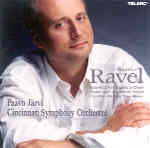These performances recall something of Paul Paray in their swiftness and bright-eyed clarity, though they miss Paray’s immediacy and impact. The Daphnis et Chloé Suite No. 2 needs greater voluptuousness, with the initial sunrise matter-of-fact rather than magical or sensuous, though the concluding General Dance features some virtuoso playing and brings the work to an exciting close. The Pavane is unkillable, and Paavo Järvi’s aptly flowing tempo certainly does it no harm. It’s also refreshing to hear a La Valse that refuses to indulge in swooning “Vienna-isms” at every point of transition. Järvi and his players build the piece steadily and generate an impressive forward momentum. The problem comes at the end, where despite generous climaxes and excellent sound the music’s descent into chaos and insanity needs just the sort of willingness to distort a phrase that the performance studiously avoids. In a word: it isn’t crazy enough.
The five little Mother Goose pieces come off best, their childlike innocence well captured at these swift tempos. While I personally prefer to hear the complete ballet with its marvelous interludes and transitional material, the excellence of the Cincinnati winds makes this version a pleasure to hear from beginning to end, and you may particularly enjoy a concluding “Fairy Garden” whose phrases knit seamlessly together, unlike the stop-and-go affair that some more lingering conductors (such as Dutoit) make of it. That leaves us with Boléro, another fast (13’30) reading that, while featuring some very stylish solos from trombone and saxophones, simply fails to accumulate sufficient intensity as its repetitions pile up. The cathartic modulation leading to the coda falls particularly flat, while the ending is anything but cataclysmic despite rich sonics that include a firm bass and plenty of presence in the brass and percussion. So while there’s much to enjoy here, this really isn’t seriously competitive with the best in this oft-recorded music.
































